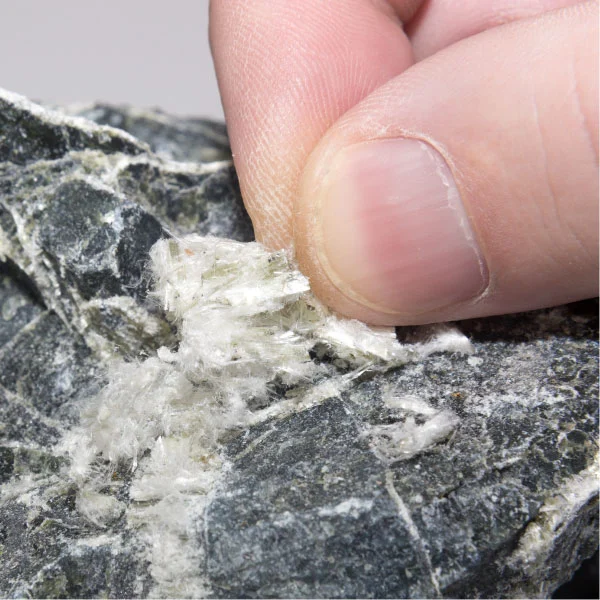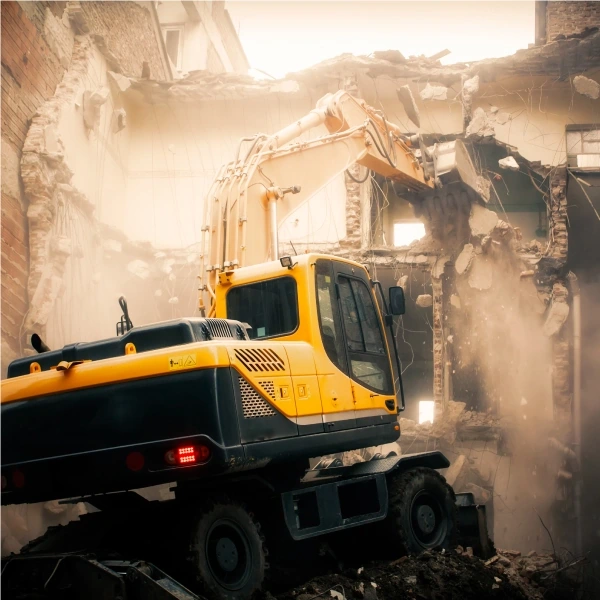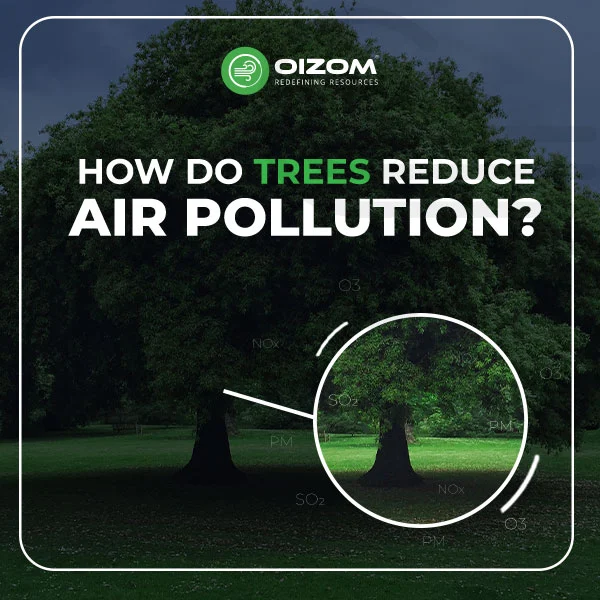Inorganic dust is a less visible dust particle but is equally important and critical. These particles are commonly called particulate matter (PM). Dusts are microscopic solid particles that disperse or suspend in the air. The particles are either “inorganic” or “organic,” depending on the source of the dust. Different types of dust have varying particle sizes, chemistry, and reactivity. Each has a unique impact on our health and the environment. This blog will explore the hidden hazards of inorganic dust, its causes, health effects, and effective prevention and control strategies. We hope to provide readers with valuable information on prevention and control strategies for inorganic dust.
What is inorganic dust?
Inorganic dust refers to particulate matter composed of non-living materials or substances that do not contain carbon-hydrogen (C-H) bonds. Inorganic dust can be produced by grinding metals or minerals like rock or soil. Inorganic dust includes silica, asbestos, and coal. These particles can vary in size, ranging from fine powders to larger granules or chunks. Minerals, rather than biological elements, are the source of inorganic dust. Inhalation of these dusts can cause lung disease (pneumoconiosis), usually after years of cumulative exposure. The most common inhaled dusts that cause disease are asbestos, silica, and coal dust. However, inhaling dust or fumes from other compounds such as aluminum, beryllium, cadmium, cobalt, copper, iron, mercury, and nickel can cause lung disease. Workers can get a range of illnesses from inhaling dust in the workplace. Some types of lung disease caused by the inhalation of dust are called “pneumoconiosis.” This simply means “dusty lung”.
Types of Inorganic Dust
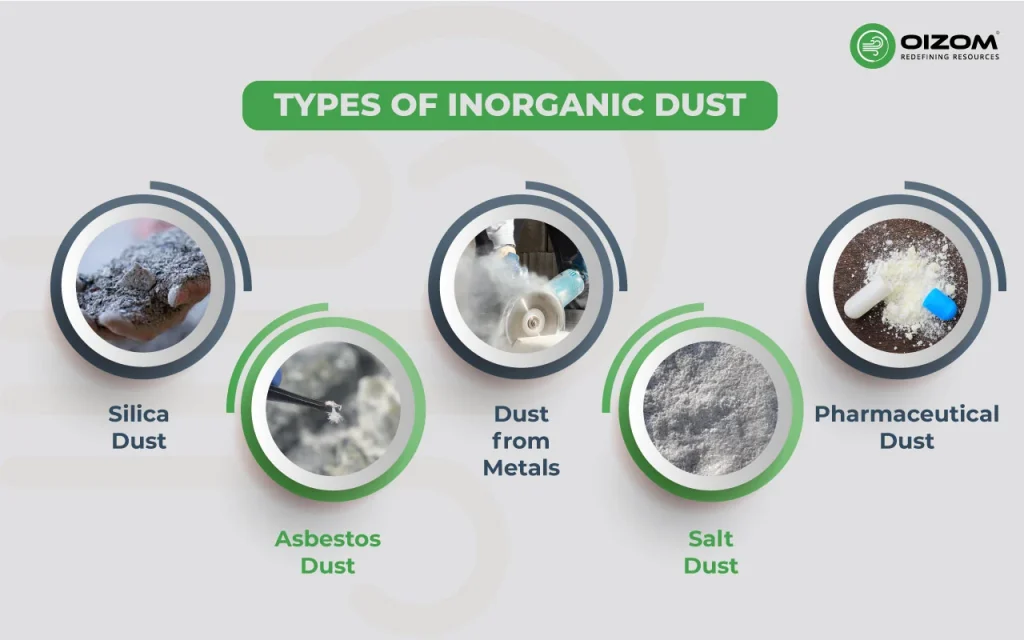
Inorganic dust encompasses a wide range of particulate matter composed of non-organic materials. Here are some common types of inorganic dust:
Silica Dust
Silica dust, the most prevalent form of hazardous dust, is derived from materials like rocks, sand, and human-made products such as glass and ceramics. Its omnipresence in construction and manufacturing makes it a common occupational hazard. Silica particles can deeply penetrate the lungs when inhaled, leading to silicosis, a debilitating lung disease. Silicosis not only impairs lung function but can also be fatal. The microscopic size of silica particles makes them particularly dangerous, as they can evade the body’s natural respiratory defences.
Asbestos Dust
Asbestos dust comprises tiny fibers previously used in various products, including building materials and insulation. Its use has significantly declined due to the discovery of its carcinogenic nature. Inhalation of asbestos fibers can lead to mesothelioma, a rare and aggressive form of cancer primarily affecting the lining of the lungs. Asbestos dust is particularly insidious because of its long latency period; symptoms may appear decades after exposure, making early detection challenging.
The three main types of asbestos are brown asbestos, known as amosite; blue asbestos, known as crocidolite; and white asbestos, known as chrysotile.
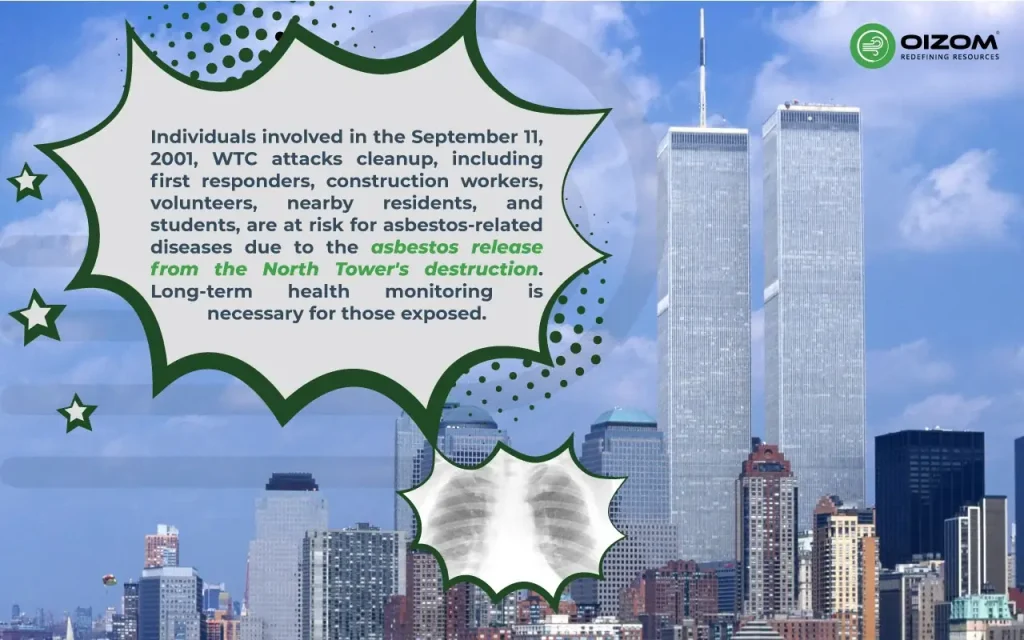
Did you know: Individuals involved in the rescue, recovery, and cleanup at the site of the September 11, 2001, attacks on the World Trade Center (WTC) in New York City are another group at risk of developing an asbestos-related disease. Because asbestos was used in the construction of the North Tower of the WTC, when the building was attacked, hundreds of tons of asbestos were released into the atmosphere. Those at most significant risk include firefighters, police officers, paramedics, construction workers, and volunteers working in the Ground Zero rubble. Others at risk include residents near the WTC towers and those who attended schools nearby. These individuals will need to be followed to determine the long-term health consequences of their exposure.
Dust from Metals
Metal dust, especially from heavy metals like lead, arsenic, and chromium, poses a grave health risk. When inhaled, these metallic particles can cause an array of health issues, including cancer, neurological disorders, and respiratory problems. Workers in the metal processing and manufacturing industries are at the highest risk. The toxicity of metal dust varies depending on the metal type, with some metals having cumulative effects that manifest over prolonged exposure.
Salt Dust
Dust from salt flats, deserts, or salt mines can contain sodium chloride particles. While generally less harmful than other inorganic dust types, high concentrations of salt dust can be corrosive and irritate the eyes, skin, and respiratory system.
Pharmaceutical Dust
Dust generated during the manufacturing of pharmaceuticals may contain inorganic components. Strict measures are taken to control exposure in pharmaceutical facilities.
The p-Phenylenediamine antioxidants (PPDs) have been widely detected in various dust samples. p-Phenylenediamine antioxidants are commonly used in tyre rubber to protect the tyres against chemical and thermal degradation. Hence, the primary source of p-phenylenediamines in the environment is dust and air particles (Tian et al., 2020))
Sources of inorganic dust
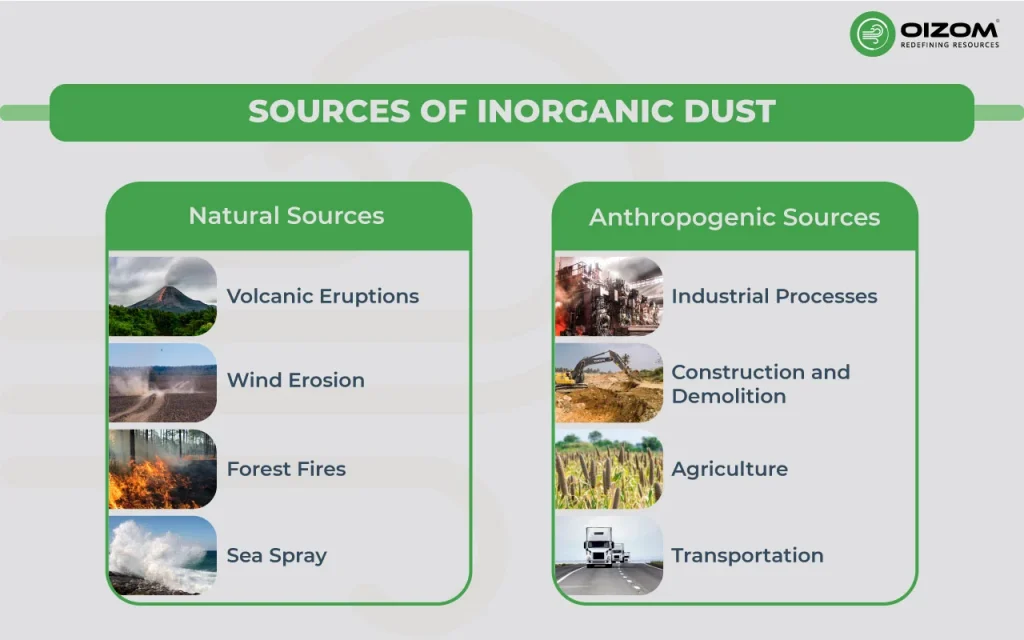
Inorganic dust can come from various sources, including natural and man-made. Here are a few common sources:
Natural Sources:
- Volcanic Eruptions: These can release significant quantities of ash and fine rock particles into the atmosphere.
- Wind Erosion: Wind can pick up and transport inorganic particles from deserts, dry lake beds, and other barren land areas.
- Forest Fires: While primarily a source of organic particles, forest fires can also release inorganic materials into the air, especially from soil and minerals.
- Sea Spray: Ocean waves and wind can generate aerosols that contain inorganic salts.
Anthropogenic Sources:
- Industrial Processes: Many industries, such as cement production, mining, and metal processing, can emit significant amounts of inorganic dust.
- Construction and Demolition: These activities can release inorganic particles like cement dust, silica, and asbestos into the air.
- Agriculture: Plowing, harvesting, and tilling can lift soil and inorganic particles into the air.
- Transportation: Road traffic stirs up dust from roads and construction sites, including particles from tire and brake wear.
Health effects of inorganic dust
Inhaling inorganic dust can have various health consequences, depending on the dust type, particle size, air concentration, and exposure length. Some of the most prevalent health concerns connected with inorganic dust exposure are:
- Breathing crystalline silica dust can lead to silicosis, which can be harmful or even deadly in extreme situations. When silica dust enters the lungs, it forms scar tissue, making it difficult for the lungs to absorb oxygen. There is no cure for silicosis.
- Silicosis impairs the immune system therefore, exposure to silica raises the risk of lung infections like tuberculosis. Furthermore, smoking damages the lungs and exacerbates the effects of silica dust exposure.
- Most studies of respiratory diseases caused by dust exposure in the agricultural workplace have focused on allergic diseases caused by inorganic dust, specifically occupational asthma and hypersensitivity pneumonitis.
- Pulmonary fibrosis (mixed dust pneumoconiosis) has been reported in agricultural workers, and dust samples from the lungs in these cases reflect the composition of farming soils, strongly suggesting a cause for inorganic agricultural dust.
- Asbestosis and Mesothelioma: Asbestos dust can cause asbestosis, a chronic lung disease, and mesothelioma, a type of cancer affecting the lining of the lungs or abdomen. As per the Study, The outlook for mesothelioma is poor. Unfortunately, only 50% live beyond a year, and only one in 10 people live beyond 5 years after diagnosis.
- Exacerbation of Pre-existing Conditions: Individuals with pre-existing respiratory conditions like asthma or bronchitis may experience worsening symptoms upon exposure to inorganic dust.
- A wide variety of lung diseases can be induced by inhaling inorganic dust. These can include airway disease, lung cancer, parenchymal disease, and pleural disease. Cadmium and mercury tend to cause non-specific pulmonary damage, which may relate to the production of reactive oxygen species.
Some types of pneumoconiosis, according to dust and lung reaction
| Inorganic Dust | Type of Disease | Lung Reaction |
|---|---|---|
| Asbestos | Asbestosis | Fibrosis |
| Silica (Quartz) | Silicosis | Fibrosis |
| Coal | Coal Pneumoconiosis | Fibrosis |
| Beryllium | Beryllium Disease | Fibrosis |
| Tungsten Carbide | Hard Metal Disease | Fibrosis |
| Iron | Siderosis | No Fibrosis |
| Tin | Stannosis | No Fibrosis |
| Barium | Baritosis | No Fibrosis |
The above table represents the types of inorganic dust with different kinds of diseases and their lung reaction.
Regulations and Safety Measures
- Occupational Safety and Health Administration (OSHA): In the United States, OSHA sets Permissible Exposure Limits (PELs) for various types of inorganic dust, specifying the maximum concentration workers can be exposed to over an 8-hour workday. These PELs vary depending on the specific dust type and potential health hazards.
- National Institute for Occupational Safety and Health (NIOSH): NIOSH provides recommendations and guidance for exposure limits and control measures for inorganic dust, which are often stricter than OSHA standards. They also research the health effects of dust exposure and develop new control technologies.
- Environmental Protection Agency (EPA): The EPA regulates air quality standards for particulate matter (PM), including PM2.5, which encompasses fine inorganic dust particles. These standards aim to protect public health from the harmful effects of air pollution.
- International Labour Organization (ILO): The ILO sets international occupational safety and health standards, including exposure limits for various dust types. These standards guide countries around the world in developing their regulations.
Safety Measures:
- Engineering controls: These measures aim to physically eliminate or reduce dust exposure at the source. Examples include ventilation systems, enclosures, wet suppression methods, and automation of dusty processes.
- Administrative controls: These measures involve procedures and policies to minimize worker exposure, such as job rotation, restricted access to dusty areas, training on safe work practices, and proper housekeeping.
Prevention and Control
Preventing and controlling inorganic dust exposure, particularly in workplaces and industrial settings, is crucial for protecting health and safety. Here are some strategies and measures commonly employed:
Engineering Controls:
- Ventilation Systems: Install and maintain proper ventilation systems to dilute and remove dust from the air.
- Dust Extraction Systems: Use local exhaust ventilation (LEV) to capture dust at its source.
- The enclosure of Dust Sources: Enclose processes that generate dust to prevent its spread.
- Wet Processes: Use water sprays or mists to suppress dust generation, especially in industries like construction and mining.
- Substitution: Replace materials that produce hazardous dust with less dangerous alternatives.
Administrative Controls:
- Workplace Policies: Implement and enforce policies and procedures for dust control and maintenance.
- Employee Training: Educate workers about dust exposure risks and proper work practices to minimize dust generation.
- Regular Maintenance: Ensure periodic maintenance and cleaning of equipment and work areas to prevent dust accumulation.
- Work Scheduling: Rotate workers or limit the time spent in dusty areas to reduce exposure.
Personal Protective Equipment (PPE):
- Respirators: Provide appropriate respirators or masks to workers, especially in high dust concentrations.
- Protective Clothing: Supply protective clothing like gloves, overalls, and goggles to minimize skin and eye exposure.
Monitoring and Surveillance:
- Air Quality Monitoring: Regularly monitor air quality in the workplace or industries to ensure dust levels are within safe limits. With solutions like Oizom’s real-time air quality monitors, you don’t have to worry about classifying different types of particulate matter. Whether it is inorganic dust, The advanced dust monitor will give you data on all dust in the air, encouraging you to take smart mitigation actions.
- Health Surveillance: Conduct health check-ups for workers exposed to significant dust levels to detect any adverse health effects early.
Conclusion
Regulating inorganic dust is essential to maintaining environmental and occupational health. Implementing complete control measures, such as adequate engineering controls, administrative methods, and personal protective equipment, is critical in reducing the health risks associated with dust exposure. Regular air quality monitoring with real-time air quality monitors and health surveillance are crucial for early detection and prevention of adverse health outcomes. Adherence to laws and spreading knowledge about the dangers of inorganic dust improves safety practices. Recognizing that prevention and control of inorganic dust is a common duty involving collaboration from industries, workers, and environmental organizations is crucial.
FAQs
Common sources of inorganic dust include construction sites, mining operations, metalworking industries, and natural sources like volcanic ash. This dust can also originate from industrial processes like cement manufacturing, stone cutting, and handling minerals.
Inorganic dust can be harmful as it often contains materials like silica, metals, and asbestos, which can cause respiratory issues, lung damage, and other health problems. Fine dust particles can penetrate the lungs and cause long-term health issues, including chronic respiratory diseases and certain types of cancer.
Symptoms of inorganic dust exposure can range from short-term effects like coughing, sneezing, and eye irritation to more severe long-term issues like chronic bronchitis, silicosis, and asbestosis. Prolonged exposure can also lead to decreased lung function and increased susceptibility to lung infections.
Protection from inorganic dust includes using protective gear such as masks, respirators, and goggles, especially in work environments prone to dust exposure. Ensuring proper ventilation and dust suppression systems at worksites, following safety protocols, and regularly cleaning and maintaining equipment can also help minimize exposure.
Many countries have regulations and guidelines to limit inorganic dust exposure in the workplace. These include permissible exposure limits, personal protective equipment requirements, and employers' mandates to implement dust control measures. Occupational health and safety organizations often enforce these regulations.

